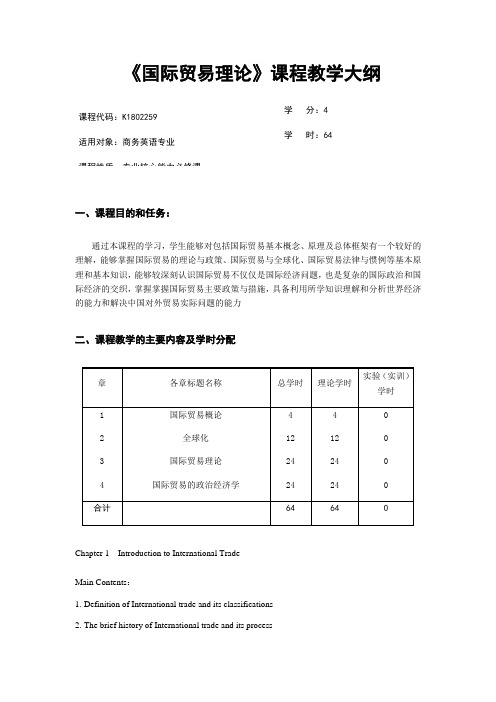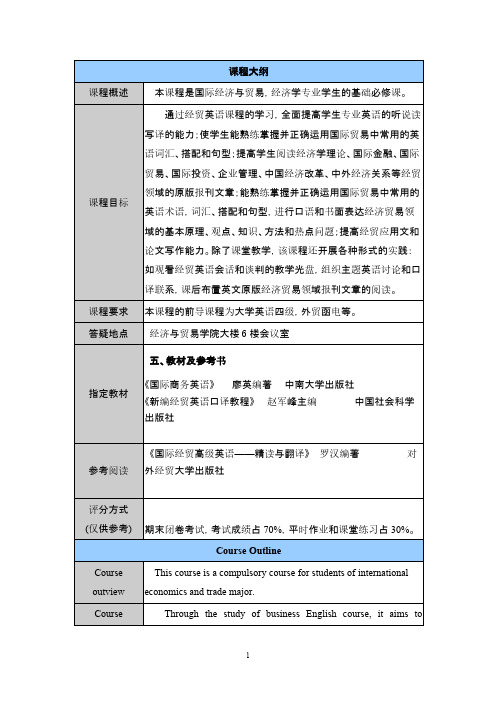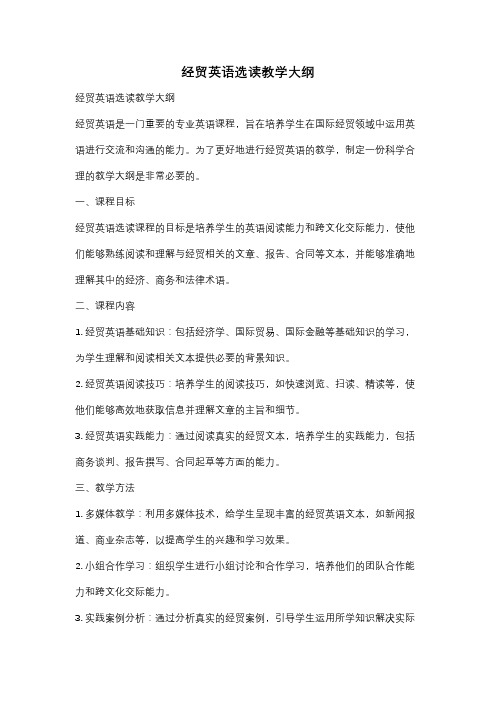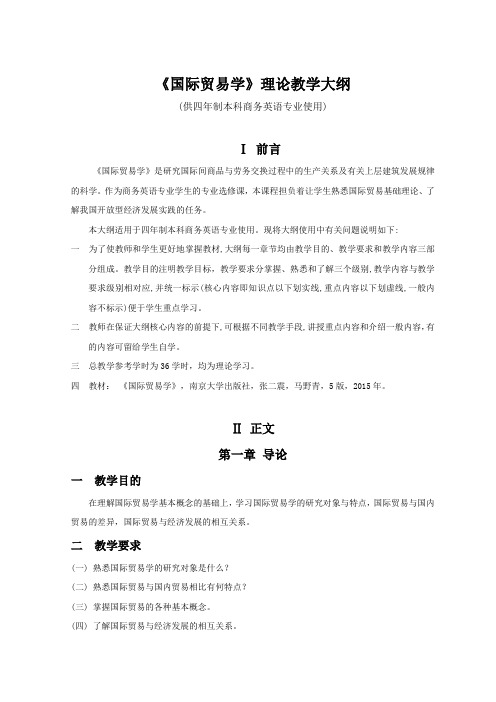经贸英语教学大纲20171
国际贸易专业英语课程教学大纲

国际贸易专业英语课程教学大纲课程名称:国际贸易专业英语课程名称:English of International Trade课程类型:专业基础课学时:72适用专业:国际贸易先修课程:英语、国际贸易实务一、课程的性质、目的与任务《国际贸易专业英语》是一门理论与实践相结合的综合性专业课。
本课程广泛涉及国际贸易理论和实务、国际金融、国际企业管理等领域的知识。
本课程的教学目的是使学生打好学习外贸函电和外贸应用文的基础,并为将来的进一步学习和研究做好准备。
通过本课程的学习,使学生为进一步掌握专业英语技能(如阅读有关资料、文献,处理英语函电,草拟商业合同、协议等文件,进行商务谈判等)打下良好的基础。
二、课程的内容第一单元:国际贸易理论(6学时)学习目的和要求:涉及国际贸易理论的专有词汇、词组和习惯用法。
通过精读、泛读、提问、讨论、翻译和写作等形式的实践和练习,能达到比较熟练地理解和表述有关国际贸易理论的概念及有关话题。
通过泛读的方式了结国际贸易理论的新发展。
重点难点:有关国际贸易理论的词汇和阅读理解。
第二单元国际贸易政策(5学时)学习目的和要求::阅读有关国际贸易政策的文章,学习涉及国际贸易政策的专有词汇、词组和习语。
通过精读、泛读、提问、讨论、翻译和写作等形式的实践和练习,能达到比较熟练地理解和表述有关国际贸易政策的概念及有关话题。
通过泛读和讨论的形式了解世界各国的国际贸易政策。
重点难点:有关国际贸易理论的词汇、用法和阅读理解。
第三单元:国际贸易方式(6学时)学习目的和要求:涉及国际贸易方式的专有词汇、词组和习惯用法。
通过精读、泛读、提问、讨论、翻译和写作等形式的实践和练习,能达到比较熟练地理解和表述有关国际贸易方式的概念及有关话题。
阅读时文,了解我国主要的国际贸易方式重点难点:掌握有关国际贸易方式的专业词语、用法和阅读能力。
第四单元:国际贸易收支(6学时)学习目的和要求:精读国际贸易收支方面的经典文章,学习和掌握此方面的词汇和习语。
国际贸易实务(英语)-教学大纲

Outline of International Trade Practice(English)Course Code: 030243ACourse Mode:required coursePeriods: 48 lecturing: 32 Experiment: 16 Credits: 3Preparatory Courses:International Trade (English)Majors: International Trade一、Objectives of LecturingInternational Trade Practices (English) is a main course for students majoring in international trade. This course focuses on the basic procedures involved in international trade. This course should help the students have a general idea of the basic procedures involved in international trade and grasp the basic operating techniques concerned.二、Basic Requirement of Lecturing and its relationship with graduationThe contents involve international trade terms, terms of commodities, international cargo transport, cargo insurance, terms of price, international payment and settlement, claims, force majeure and arbitration, business negotiation and establishment of contract, etc. Among these, we should emphasize on international trade terms, terms of commodities, international cargo transport, cargo insurance.The lecturing methods of this course are the com bination of the teacher’s lecturing and the students’ imitative practices, based on the multi-medias. The students can learn the difficulties and the major parts through the lecturing and the practice.The students should analyze the cases based on the knowledge they have grasped. They should improve their abilities through imitative practices. Meanwhile they should practice trade forms by themselves.三、The allocation of periods for the contentsAllocation四、Contents of LecturingChapter 1 International Trade Terms1.1Generalization1.2 A Guide to Incoterms 2000 and 20101.3Incoterms and ContractsThe difficulties and the major parts: the definition of trade terms, the responsibilities and obligations born by the buyer and the seller in each trade terms.Learning criterion: After learning the chapter, the students should have a general idea of the function of the trade terms, understand the implication and features of each trade terms and grasp the differences among certain trade terms.Exercises: Case studyChapter 2 Terms of Commodity2.1 Name of Commodity2.2 Quality of Commodity2.3 Quantity of Commodity2.4 Packing of Commodity2.5 Commodity Inspection and Customs FormalitiesThe difficulties and the major parts: the methods to stipulate the name of the commodity and the quality, calculation of weight, neutral packing.Learning criterion: After learning the chapter, the students should have a general idea of the name of commodity, the quality, the quantity and the packing, understand the methods to describe the name of commodities and the quality, and grasp the techniques to describe the name of commodities the quality, the quantity and the packing in the international contract.Exercise: Case studyChapter 3 International Cargo Transport3.1 Modes of Transport3.2 Clause of Shipment3.3 Major Shipping DocumentsThe difficulties and the major parts: ocean transport, clause of shipment, the function and the type of the bill of ladingLearning criterion: After learning the chapter, the students should have a general idea of the mode of transport and its features, understand the clause of shipment and grasp the function and the type of the B/L.Exercise: Case studyChapter 4 Cargo Insurance4.1 Parties to the Insurance4.2 Marine Insurance4.3 Insurance of Land, Air and Postal Transportation4.4 Fundamental Principles of Cargo InsuranceThe difficulties and the major parts: types of risks, losses and expenses covered, scope of insurance coverageLearning criterion: After learning the chapter, the students should have a general idea of the scope of insurance coverage, understand the implication of basic coverage and additional coverage and their respective scope of insurance coverage, and grasp the methods to cover insurance in international trade.Exercise: Case studyChapter 5 Terms of Price5.1 Conversion of Major Trade Terms5.2 Exchange Cost5.3 Money of Account and Avoidance of Foreign Exchange Risk5.4 Use of Commission and Discount5.5 Clause of PriceThe difficulties and the major parts: conversion of major trade terms, exchange cost, use of commission and discountLearning criterion: After learning the chapter, the students should have a general idea of the pricing strategies, understand the implication and use of commission and discount, and grasp the conversion of major trade term, exchange cost and clause of price.Exercise: Case studyChapter 6 International Payment and Settlement6.1 Payment Currency6.2 Credit Instruments6.3 Payment Methods6.4 Risk Level Assessment of PaymentsThe difficulties and the major parts: collection and letter of creditLearning criterion: After learning the chapter, the students should have a general idea of the flow of a documentary credit and a collection, understand the implication and features of remittance, collection and L/C, and grasp the chief contents and the varieties of the L/C.Exercise: Case studyChapter 7 Claims, Force Majeure and Arbitration7.1 Claims7.2 Force Majeure7.3 ArbitrationThe difficulties and the major parts: claims, force majeure and arbitrationLearning criterion: After learning the chapter, the students should have a general idea of the definition of the terms such as claims, force majeure and arbitration, understand the function of the clause of force majeure, and grasp the force majeure clause in the contract.Exercise: Case studyChapter 8 Business Negotiation and Establishment of Contract8.1 Enquiry8.2 Offer8.3 Counter-offer8.4 Acceptance8.5 Conclusion of ContractThe difficulties and the major parts: offer with engagement, conclusion of contractLearning criterion: After learning the chapter, the students should have a general idea of the stages in the business negotiation, understand the two required factors, and grasp the meaning of acceptance and conclusion of contract.Exercise: Case study五、ExaminationThis subject adopts a written examination, with the final score accounting for 70% and imitative practices accounting for 30%.六、Bibliography[1] William G. Nickels, James M. McHugh, Susan M. McHugh. Understanding Business. 6th ed. McGraw-Hill. 2002[2] Paul R. Krugman and Maurice Obstfeld. International Economics---theory and Policy. 5th ed. Addison Wesley Longman & 清华大学出版社,2002[3] Lillian H. Channey and Jeanette S. Martin. Intercultural Business Communication. 2nd ed. Pearson Education. 2002[4] 帅建林.International Trade Practices (Second Edition). Beijing: University of International Business and Economics Press. 2012[5]帅建林.International Trade Practices (Third Edition). Beijing: University of International Business and Economics Press. 2015执笔人:于晓云教研室主任:系教学主任审核签名:。
国际贸易理论教学大纲英文

《国际贸易理论》课程教学大纲一、课程目的和任务:通过本课程的学习,学生能够对包括国际贸易基本概念、原理及总体框架有一个较好的理解,能够掌握国际贸易的理论与政策、国际贸易与全球化、国际贸易法律与惯例等基本原理和基本知识,能够较深刻认识国际贸易不仅仅是国际经济问题,也是复杂的国际政治和国际经济的交织,掌握掌握国际贸易主要政策与措施,具备利用所学知识理解和分析世界经济的能力和解决中国对外贸易实际问题的能力二、课程教学的主要内容及学时分配Chapter 1 Introduction to International Trade Main Contents :1. Definition of International trade and its classifications2. The brief history of International trade and its process3.The role and status of International trade.3.1International trade and Country3.2International trade and corporate3.3International trade and peopleObjectives:After finish learning this chapter,the students are able to1.have a general idea about International trade;2.Know the brief history of international trade;3.Know the main issues concerning international trade. Important and Difficult points:Definition of international trade; why international tradeChapter 2 GlobalizationMain contents:1.The definition of globalization and its genre;1.1The globalization of markets;1.2The globalization of production;2.The emergence of global institutions2.1WTO2.2IMF and WB2.3UN3.Drivers of globalization4.The changing demographics of the global economy5.The changing world order;6.The debate on GlobalizationObjectives:After finish learning this chapter,the students are able to1.Understand what is meant by the term globalization;2.Recognize the main drivers of globalization;3.Describe the changing nature of the global economy;4.Explain the main arguments in the debates over the impact of globalization;5.Understand how the process of the globalization is creating opportunities and challenges for business managersImportant and Difficult points:Definition of globalization; drivers of globalization; the changing world economy and order. Chapter 3 International Trade TheoryMain contents:1.An overview of trade theory1.1The benefits of trade;1.2The pattern of international trade;1.3Trade theory and government policy;1.4Mercantilism Absolute advantage1.5Comparative advantage;1.6The gains from trade1.7Qualifications and assumptions1.8Extensions of he Ricardian Model;1.9Heckscher-ohlin theory;1.10The Leontief paradox;1.11The product Life-cycle theory;2.New trade theory2.1Increase product variety and reducing costs;2.2Economies of Scale, first-mover advantages,and the pattern of trade;2.3Implication of new trade theory;2.4National competitive advantage: Poter’s Diamond;3.Implications for managers.Objectives:After finish learning this chapter,the students are able to1.Understand why nations trade with each other;2.Summarize the different theories explaining trade flows between nations;3.Recognize why many economists believe that unrestricted free trade between nations will raisethe economic welfare of countries that participate in a free trade system;4.Explain the arguments of those who maintain that government can play a proactive role inpromoting national competitive advantage in certain industries;5.Understand the implications that international trade theory holds for business practice.Important and Difficult points:the international trade theory, the new trade theory.Chapter 4 The Political Economy of International TradeMain contents:1.Instruments of Trade Policy1.1Tariffs1.2Subsidies1.3Import quotas and voluntary export restraints1.4Local content requirements1.5Administrative Policies1.6Anti-dumping policies2.The case for Government intervention2.1Political arguments for intervention2.2Economic arguments for intervention3.The revised case for free trade3.1retaliation and trade war3.2Domestic policies4.Development of the world trade system4.1GATT, Trade liberalization, and economic growth: 1947-1979;4.2Protectionist trends: 1980-1993;4.3The Uruguay round and the WTO;4.4Experience to date: WTO4.5The Future of the WTO: Unsolved Issues and the Doha round5.Implications for managers5.1trade barriers and firm strategy5.2Policy implicationsObjectives:After finish learning this chapter,the students are able to1.Identify the policy instruments used by governments to influence international trade flows;2.Understand why governments sometimes intervene in international trade;3.Summarize and explain the arguments against strategic trade policy;4.Describe the development of the world trading system and the current trade issues;5.Explain the implications for managers of developments in the world trading system.Important and Difficult points:the policy instruments used by governments to influence international trade flows; the world trading system and its development三、课程实施建议本课程建议采用CBL、PBL等多种教学方法和手段。
【VIP专享】经贸英语教学大纲

经贸英语教学大纲、、课程信息开课单位经济与贸易学院课程编号21035课程名称经贸英语英文名称Business English课程性质专业任选课学分3总学时48先修课程国际贸易学开课学期第6学期适应专业国贸专业二、课程内容(一)课程教学目标通过对该课程的学习,全面提高学生专业英语的听说读写译的能力,熟练掌握并正确运用国际贸易中常用的英语词汇、搭配和句型,看懂经贸类原版书籍、报刊、杂志等,能用英文口语和写作表达经济贸易领域的基本原理、观点、知识、方法和热点问题。
(二)基本教学内容Unit one: international businessFocus points:1. what is business?2. What is international business?3. The scope of international business activities.4. International risk.5. on international business law.6. Commercial credit.7. on management of international business.8. Brief introduction to WTO.Unit two: business organizationsFocus points:1.Introduction2.sole proprietorship3.general partnership.4.limited partnership5.joint stock company6.corporations.Unit three ways of businessFocus points:1.introduction2.wholesaling3.retailing4.franchising5.agency6.electronic commerceunit four a guide to economicsFocus points:1.what is economics?2.what is macroeconomics?3.monetary and fiscal policy4.what is microeconomics?5.the demand curve6.the supply curve7.the equilibrium price8.changes in demand versus changes in quantity demanded9.changes in supply versus changes in quantity supplies.Unit five the market economyFocus points:1.market and market economy2.price3.supply and demand4.the market priceunit six what it marketingFocus points:1.what is marketing2.the marketing concept3.marketing and utility4.the target market5.the industrial marketernment and institutional markets7.the consumer market8.classes of consumer goods9.unit 7 the marketing mix and product promotionFocus points:1.the marketing mix2.product planning3.product pricing4.selecting the market5.product promotion6.advertising7.product packaging8.breaking the language barriersunit eight international payments and settlementsFocus points:1.introduction2.credit instruments3.bill of exchange4.promissory note and cheque5.remittance6.terms and methods of payment in international trade- payment in advance, openaccount business, collection.7.terms and methods of payment in international trade- letters of credit8.guarantee9.documentsunit nine language patterns and writing ways of international business contracts. Focus points:1.the basic definition of a contract2.classification of international business contractsnguage features and writing ways of international business contract4.the structure of an international business contract5.how to draft international business contracts and agreements6.the example of a business contractunit ten international trade termsFocus points:1.introduction2.definition of the trade terms in <<incoterms 2000>>3.how to determine the price for imports and exports?4.selection of money accountmission and discount6.other non-price commercial technical terms.Unit eleven introductions to international business practiceFocus points:1.introduction2.business preparatory work3.boniness negotiation4.the signing of a contract5.the performance of export contract6.the performance of import contractunit twelve negotiation strategies on international businessFocus points:1.introduction2.the preparations for business negotiation3.the notable problem during the process of negotiation.(三)实践环节要求课堂组织观看经贸英语会话的教学光盘,组织主题英语讨论和会话和翻译联系,课后布置英文原版经济贸易领域报刊文章的阅读。
国际贸易实务(英)教案

教案课程名称国际贸易实务(英)授课学期 2016-2017第二学期授课教师YLL教学单位外国语系教务处制《国际贸易实务》教案To get to know the terms .Master the terms of International trade.To know general basic theoriesKnow reasons,benefits and problems of the international trade.I.Reasons For International Trade1. Resource reasons2. Economic reasons3. Political reasonsII.Benefit of International Trade1. Cheaper goods2. Greater variety when goods come from more countries3. Wider market with increasing number of trading partners4. Growth of economyIII.Problems in International Trade1. Trade restrictions2. Cultural Problems3. Monetary conversion1.Trade restrictionsdiversified economyprotect their vital industriesinfant industryunfair competitiondomestic jobsmaintain balance of trade and balance of paymentpure political reason2) Kinds of restrictions(1)Tariffs (tariff barriers)Import duty and Export dutyImport surtax : Countervailing duty ,anti-dumping duty, variable levySpecific dutyAd valorem dutyMixed or compound dutyAlternative duty(2) Non-tariff barriersQuotaImport licenseForeign exchange controlForeign exchange controlState monopoly of import and exportGovernment procurement policyAdvanced depositTechnical standardsHealth & sanitary regulationsPackaging and labeling regulationMinimum price《国际贸易实务》教案To acquire the basic knowledge of termsTo know how to use the termsMaster the definition of 13 trade terms.Know the difference and same among them(各种贸易术语的含义及使用中注意的问题,在装运港交货的三种常用术语的变形,相邻或相似术语之间的异同对比)FGroup F: FCA FAS FOBFGroup C: CFR CIF CPT CIPFGroup D: DAS DES DEQ DDU DDP各组贸易术语总结E组术语(启运术语,Departure)F组术语(主运费未付术语,Main Carriage Unpaid)C组术语(主运费已付术语,Main Carriage Paid)D组术语(到达术语,Arrival)注:C组术语的风险划分界限和费用划分界限相分离注:以F组和C组术语成交的合同都属于装运合同。
经贸英语选读教学大纲

经贸英语选读教学大纲经贸英语选读教学大纲经贸英语是一门重要的专业英语课程,旨在培养学生在国际经贸领域中运用英语进行交流和沟通的能力。
为了更好地进行经贸英语的教学,制定一份科学合理的教学大纲是非常必要的。
一、课程目标经贸英语选读课程的目标是培养学生的英语阅读能力和跨文化交际能力,使他们能够熟练阅读和理解与经贸相关的文章、报告、合同等文本,并能够准确地理解其中的经济、商务和法律术语。
二、课程内容1. 经贸英语基础知识:包括经济学、国际贸易、国际金融等基础知识的学习,为学生理解和阅读相关文本提供必要的背景知识。
2. 经贸英语阅读技巧:培养学生的阅读技巧,如快速浏览、扫读、精读等,使他们能够高效地获取信息并理解文章的主旨和细节。
3. 经贸英语实践能力:通过阅读真实的经贸文本,培养学生的实践能力,包括商务谈判、报告撰写、合同起草等方面的能力。
三、教学方法1. 多媒体教学:利用多媒体技术,给学生呈现丰富的经贸英语文本,如新闻报道、商业杂志等,以提高学生的兴趣和学习效果。
2. 小组合作学习:组织学生进行小组讨论和合作学习,培养他们的团队合作能力和跨文化交际能力。
3. 实践案例分析:通过分析真实的经贸案例,引导学生运用所学知识解决实际问题,提高他们的实践能力和创新思维。
四、评估方式1. 课堂表现:考察学生在课堂上的积极参与程度、合作能力和表达能力。
2. 作业和考试:布置相关的作业和考试,以检验学生对经贸英语知识和阅读技巧的掌握程度。
3. 项目实践:组织学生进行实际的经贸项目实践,评估他们的实践能力和综合素质。
五、教学资源1. 教材:选择经济学、国际贸易、商务英语等方面的教材,结合实际情况进行适当调整,以满足学生的学习需求。
2. 电子资源:利用互联网和电子数据库等资源,提供大量的经贸英语文本和资料,供学生进行阅读和研究。
六、教学效果评估1. 学生满意度:通过问卷调查等方式,了解学生对经贸英语选读课程的满意度和反馈意见,以不断改进教学质量。
《国际贸易学》理论教学大纲(供四年制本科商务英语专业使用)

《国际贸易学》理论教学大纲(供四年制本科商务英语专业使用)Ⅰ前言《国际贸易学》是研究国际间商品与劳务交换过程中的生产关系及有关上层建筑发展规律的科学。
作为商务英语专业学生的专业选修课,本课程担负着让学生熟悉国际贸易基础理论、了解我国开放型经济发展实践的任务。
本大纲适用于四年制本科商务英语专业使用。
现将大纲使用中有关问题说明如下:一为了使教师和学生更好地掌握教材,大纲每一章节均由教学目的、教学要求和教学内容三部分组成。
教学目的注明教学目标,教学要求分掌握、熟悉和了解三个级别,教学内容与教学要求级别相对应,并统一标示(核心内容即知识点以下划实线,重点内容以下划虚线,一般内容不标示)便于学生重点学习。
二教师在保证大纲核心内容的前提下,可根据不同教学手段,讲授重点内容和介绍一般内容,有的内容可留给学生自学。
三总教学参考学时为36学时,均为理论学习。
四教材:《国际贸易学》,南京大学出版社,张二震,马野青,5版,2015年。
Ⅱ正文第一章导论一教学目的在理解国际贸易学基本概念的基础上,学习国际贸易学的研究对象与特点,国际贸易与国内贸易的差异,国际贸易与经济发展的相互关系。
二教学要求(一) 熟悉国际贸易学的研究对象是什么?(二) 熟悉国际贸易与国内贸易相比有何特点?(三) 掌握国际贸易的各种基本概念。
(四) 了解国际贸易与经济发展的相互关系。
三教学内容(一) 国际贸易的基本概念。
(二) 国际贸易的分类与特点。
(三) 国际贸易与经济发展的关系。
第二章国际贸易的利益一教学目的在理解国际分工基本概念的基础上,学习当代国际分工的新特征、水平型分工的概念,国际分工的发展历程,国际分工的静态利益与动态利益。
二教学要求(一) 掌握国际分工的概念、当代国际分工的新特征、水平型分工的概念。
(二) 熟悉国际分工的发展历程、影响其发展的因素、国际贸易的动态利益。
(三) 了解国际产业转移新趋势、国际分工与国际贸易的关系、静态利益、国际贸易利益怎么实现。
经贸英语课程标准内容

一、课程性质与定位(一)、课程性质《经贸英语阅读教程》是为310英语专业的学生开设的一门英语课程。
本课程的教学目的是培养学生掌握阅读和理解商务英语文章的基本技能,掌握一些国际经济文章中常用词汇,懂得一般的商务表达,熟悉主要的商务英语文章类型,为进一步学习后续的商务英语课程,毕业后成为适应社会需要的应用型涉外商务工作者打下坚实的基础。
(二)、课程定位本课程为310英语专业学生在第四学期学习的职业拓展模块课程,属于B 类。
二、课程教学目标与任务(一)、课程教学目标培养学生的英语阅读理解能力和提高学生的阅读速度;培养学生细致观察语言的能力以及假设判断、分析、归纳推理检验等逻辑思维能力;并通过阅读训练帮助学生扩大阅读量,吸收语言和文化背景知识。
(二)、课程教学任务通过学习有关的商务活动的实用语言材料,学生应熟悉主要的商务英语文章类型,提高阅读商务文章的能力。
通过学习,学生应进一步提高基本的听、说、读、写、译的能力。
·要求:1.熟悉主要商务英语文章的类型。
2.能读懂主要英语报刊、杂志上面有关商务活动的难度适中的报道和评论。
3.能将一般性英语商务材料译成汉语,要求译文符合原义,行文顺畅;同时,进行一些中英句子翻译,主要目的是让学生学会商务文章中最常用的表达方法的实际运用。
4.熟练阅读、正确理解并逐渐学会欣赏商务文章的语言和文字魅力,具备初步的独立分析能力。
5.通过有效的阅读训练,学会解读商务英语文章的段落大意和中心思想;在正确理解的基础上,撰写文章概要和与文章主题相关的小论文等。
三、先修及后续课程(一)先修课程:英语泛读(二)后续课程:无四、教学内容与要求Unit 1 国际经济组织本章教学目标:(1).掌握TextA和TextB中的单词短语.(2).通过阅读能把握文章的主要大意。
(3).了解世界旅游组织的作用。
本章教学重点:单词短语。
本章教学难点:在规定的时间内能较准确地完成所给习题.Unit 2国际金融本章教学目标:(1).掌握TextA和TextB中的单词短语.(2).通过阅读能把握文章的主要大意。
国际经济与贸易专业(全英文授课)教学大纲

国际经济与贸易专业(全英文授课)Syllabus of Calculus for Business and Economics Course Code: MATH1001Total Teaching Hours:64Total Credits: 4Pre-required Courses: Basic knowledge of MathematicsCourse DescriptionThis course is a required mathematical course for the Business-studying students. Calculus is the fundamental of the following course, such as statistics. In this course, students will learn to use the advanced mathematical knowledge to solve the applied problems in Business and Economics. Also the purpose of this course is to prepare the students for the following special course.Required Texts & MaterialsRaymond A.Barnett,Micheal R. Ziegler, Karl E. Byleen. Calculus for Business, Economics, Life Science, and Social Science(Ninth Edition),Higher Education Press,2005GradingHomework Assignments and Class Participation, etc. 30%Final Exam 70%The grades will be assigned as follows:90-100 A80-89 B70-79 C60-69 D0-59 FAssessmentsHomework Assignments - There will be homework assignments every weeks. You may discuss homework questions with your classmates; however, it has to be your individual work. You have to submit your solution file for each assignment immediately after you are notified. The due date for each assignment will be announced when the homework are assigned. Late submission will cause penalty on the grade.Final Exam - The written final exam will be given at end of the semester. The exam duration is 2 hours. The final exams will focus on the text, lectures and homework assignments. It will consist of 7 multiple-choice questions, 7 short answers, 4 calculation problems and 3 application questions. A sample of the final exam will be posted for your reference before the exam.Class AttendanceSchool policy dictates that attendance is mandatory. You should come to every class on time, stay for the entire class, and be attentive during the class unless you have a family or health related emergency. If you do miss a class it is your responsibility to get lecture notes and assignments from another student. If you miss more than three classes the Instructor reserves the right to drop you from the course.Class PreparationAs a guideline, you should expect to spend at least 3 hours per week preparing for class. I will let you know what we will study next week. Do not get behind. You need to spend significant time on class preparation before every class rather than letting work pile up.。
《经贸英语口语》教学大纲.doc

《经贸英语口语》教学大纲国际经济与贸易专业课程教学大纲《经贸英语口语》教学大纲课程名称:经贸英语口语课程类别:专业方向课总学时:80学时开课学期:第6学期适用对象:国际经济与贸易专业本科生编者:张东芳一、本课程的性质与目的《经贸英语口语》是国际经济与贸易专业的专业方向课,它涉及外贸交易的各方面。
通过本课程的学习,学生应掌握经贸英语交流的基本技能,成为适应社会需要的应用型涉外商务工作者。
学生应具有较高的听、说和口译的能力。
了解英语国家的社会和商业文化,能够在不同的商务场合中使用恰当的英语。
通过学习有关商务活动的真实语言材料,学生应熟悉并掌握当代商务理念和国际商务惯例;拥有作为商务工作者的基本素质,具有较强的商务交际能力和团队协作精神,以及不懈的创新意识。
二、本课程的要求本课程要求学生熟记相关的词汇和句型,学会使用规范的商务英语,了解贸易洽谈的程序及商务交际特定的社会文化环境,掌握对外贸易洽谈的技巧,从而在整体上提高运用英语的能力、在不同商务情景中的交际能力和涉外商务洽谈水平。
三、本课程的内容第一课接待来访代表团及个人1(对话范例11(替换练习111(翻译练习IV (情景对话通过学习,掌握在接待客人和代表团时的常用句式,熟悉在这些情景中经常会谈论的问题,了解初次交往过程中的一些相关礼仪,培养学生接待外宾的能力。
重点初次见面及随后的电话沟通。
难点见面之后如何寒暄。
第二课询价1(对话范例11(替换练习111(翻译练习IV (情景对话通过学习,掌握询价时常用的句式,熟悉询价时常询问的问题,了解询盘的常见问题。
重点和难点对于价格的比较和询问。
第三课磋商价格1国际经济与贸易专业课程教学大纲1(对话范例11(替换练习111(翻译练习IV (情景对话通过学习,熟悉并掌握在磋商价格时常用的句式,了解在价格谈判时常用的技巧。
重点和难点价格磋商的技巧。
第四课订购1(对话范例11(替换练习111(翻译练习IV (情景对话通过学习,熟悉并掌握定购时对于数量、交货期、品牌的规定等,了解在定购时需要确定的问题。
经贸专业英语 II-教学大纲

《经贸专业英语》(Ⅱ)教学大纲课程编号:031352B课程类型:专业选修课总学时:32 讲课学时:32 实验(上机)学时:0学分:2适用对象:经济学、国际经济与贸易、贸易经济等先修课程:大学英语/国际贸易/国际贸易实务一、教学目标随着企业和个人面对面对外商进行商务交际活动的机会的增加,对商务英语听说能力的培养已显得日趋重要。
《经贸专业英语》(Ⅱ)遵循“在商务环境中学习语言,通过语言提高商务知识与技能”的宗旨,以简洁易懂的语言生动、系统地介绍了涉外商务活动中常用的英语对话和技巧。
教师在教学中为学生提供各种商务英语听说情景,让学生能够有充分的机会将商务知识与技能以及语言知识与技巧融会贯通,为将来更好地从事跨文化商务交际奠定良好的基础。
目标1:学生应熟悉涉外商务活动中常用的英语对话和技巧;目标2:学生应能将商务知识与技能以及语言知识与技巧融会贯通,为将来更好地从事跨文化商务交际奠定良好的基础。
二、教学内容及其与毕业要求的对应关系《经贸专业英语》(Ⅱ)以培养学生的实际商务英语听说能力和沟通能力为主要目的,以商务领域流行的话题为依据,通过课堂大量的听力和口语活动,将学生在其它课上所学到的商务理论知识和课文里的商务词汇相结合,最终达到表达和沟通的目的。
教学内容包括各种商务英语听说情景,如面试、职业介绍、公司展示、产品展示、公司经营、办公自动化、商务旅游等。
教学方法为借助于多媒体的教师课堂讲授与学生课堂讨论、课堂展示、师生互动相结合的形式。
为提高学生自主学习的积极性,学生需加强课后查阅资料、在课堂上分享研究成果并对某一话题进行课堂讨论。
三、各教学环节学时分配教学课时分配四、教学内容Chapter 1 Job Interview教学重点和难点:how to talk about personal details, how to talk about educational background, how to talk about work experience, how to talk about qualifications and special skills, how to talk about remuneration and fringe benefits 考核要求:通过学习,学生应了解如何介绍个人信息,理解教育背景的含义,掌握工作经历的说明方法,并运用所学知识模拟面试过程。
- 1、下载文档前请自行甄别文档内容的完整性,平台不提供额外的编辑、内容补充、找答案等附加服务。
- 2、"仅部分预览"的文档,不可在线预览部分如存在完整性等问题,可反馈申请退款(可完整预览的文档不适用该条件!)。
- 3、如文档侵犯您的权益,请联系客服反馈,我们会尽快为您处理(人工客服工作时间:9:00-18:30)。
《经贸英语》教学大纲
一、课程基本信息
1、掌握对外贸易必备的基础理论和专业知识;
2、培养学生的英语运用能力,提高在实际商务环境中的英语听、说、读、写能力;
3、培养和提高学生的综合职业能力和素质。
三、课程目标、教学目标与毕业要求对应关系
四、教学基本要求和教学内容
Unit 1 Overview of International Trade
1、基本要求
掌握本单元英文生词及相关术语表达;能用英语对国际贸易进行简单介绍;了解国际贸易的概念、起源;了解当今主要的国际经贸组织;了解各国进行国际贸易的原因。
2、主要内容
(1)Text study:Concept of International Trade; Reasons for International trade
(2)Listening:Methods of going International
3、作业:课后习题
Unit 2 Commodity
1、基本要求
掌握本单元生词及与商品有关的经济贸易英语术语;能用英语对商品进行简单介绍;了解贸易中商品的属性;了解国际贸易中商品的销售方式和商品计量方式;了解商品包装相关知识
2、主要内容
(1)Text study:Two Qs of Commodity; Packaging of Commodities
(2)Listening:Commodity inspection and customs control
3、作业课后习题
Unit 3 Exporting Process
1、基本要求
掌握本单元生词及与出口报盘及询盘有关的英文术语表达;熟悉外贸出口流程。
2、主要内容
(1)Text study:Inquiry and Offer; Counter Offer
(2)Listening:Acceptance
3、作业:课后习题
Unit 4 International Trade Negotiation
1、基本要求
掌握本单元生词及与国际贸易谈判及签订合同有关的英文术语表达;能够用英语进行简单的商务谈判;了解国际贸易谈判的必要性;了解商务谈判流程和谈判技巧。
2、主要内容
(1)Text study:Steps of Business Negotiation;Effective Negotiation
(2)Listening:Tactics of Negotiation
3、作业: 课后习题
Unit 5 Signing a Contract
1、掌握本单元生词及与签订合同有关的英文术语表达;了解合同的法律要素;能够起草简
单的英文商贸合同。
2、主要内容
(1)Text study:Contract; Legal Elements of a Contract
(2)Listening:Drafting a Contract
3、作业: 课后习题
Unit 6 Insurance
1、基本要求
掌握本单元生词及与保险有关的英文术语表达;能够读懂英文保险原文;了解船舶保险相关条例;了解海上航运条例。
2、主要内容
(1)Text study:Hull Insurance Clauses; Ocean Marine Cargo Clause(I)
(2)Listening: Ocean Marine Cargo Clause(II)
作业: 课后习题
Unite 7 Delivery of Goods
1、基本要求
掌握本单元生词和与交货有关的英文术语表达;掌握常见国际贸易术语缩写;了解国际贸易术语解释通则和国际商会概况。
2、主要内容
(1)Text study:INCOTERMS 2010; Delivery
(2)Listening:ICC (International Chamber of Commerce)
3、作业:课后习题
Unit 8 International Cargo Transportation
1、基本要求
掌握本单元生词及与国际货物运输有关的英文术语表达;了解国际贸易中主要的货物运输的方式及其特点。
2、主要内容
(1)Text study:Transportation in Logistics; International Air Transport
(2)Listening:International Road Transport and Rail Transport
3、作业:课后习题
Unit 9 Bill of Lading
1、基本要求
掌握本单元生词及与提单有关的英文术语表达;了解提单的概念、内容、作用和主要类型;了解有关提单的主要国际法规;能够起草简单的提单。
2、主要内容
(1)Text study: Concept and Functions of Bill of Lading; Classifications of Bill of Lading
(2)Listening: International Conventions Governing Bill of Lading
3、作业:课后习题
Unit 10 International multi-modalism (国际多式联运)
1、基本要求
掌握本单元生词及与国际多式联运有关的术语英文表达;了解国际运输的优势;了解多式联运的发展。
2、主要内容
(1)Text study: Multi-Modalism; Intermodal Transportation Advantage
(2)Listening Development of Inter-modal Transportation
3、作业:课后习题
Unit 11 International Payment
1、基本要求
掌握本单元生词及与国际支付有关的术语英语表达;了解国际贸易支付方式;了解汇票、本票、支票、信用证的特点。
2、主要内容
(1)Text Study: Method of Payment in International Trade; Bill of Exchange;
(2)Listening: Cheque and Promissory Note
3、作业:课后习题
Unit 12 Arbitration, Force Majeure and claims
1、基本要求
掌握本单元生词及与仲裁和索赔有关的术语的英语表达;了解仲裁的作用、仲裁条款包含的事项和不可抗拒力的类型;了解索赔条款的种类以及作用。
2、主要内容
(1)Text Study: Arbitration; Force Majeure
(2)Listening: Claims
3、作业:课后习题
Unit 13 Modes of International Trade
1、基本要求
掌握本单元生词;了解代理、分销、寄售、合资、许可、特许经营等国际贸易方式的特点及相关术语表达。
2、主要内容
(1)Text Study: Agency, Distribution and Consignment; Joint Ventures
(2)Listening: Licensing and Franchising
3、作业:学生以小组为单位分别从以下题目中选择一项搜集相关资料,并做课堂展示,每
个小组限时10分钟。
(1)Trade Protectionism(贸易保护主义)
(2)World Trade Organization(世贸组织)
(3)The European Union(欧盟)
(4)The International Monetary Fund(国际货币基金组织)
(5)The impact of RMB appreciation (人民币升值)
(6)Trade surplus & trade deficit (贸易顺差与贸易逆差)
(7)Trade barrier(贸易壁垒)
(8)Transnational Corporations(跨国公司)
(9)International Technological Transfer(技术转让)
(10)C ommodity Futures(商品期货)
(11)I nvitation for and Submission of Bids(招标与投标)
(12)F inancial Crisis (金融危机)
(13)F inancial Sector(金融监管)
五、参考学时
课程总学时:32学时
1、本课程的课程教学以课堂讲授为主,教学媒体以文字教材和录音教材为主,辅以少量的录像教材,结合补充材料阅读及小组汇报演讲组织教学。
2、课程的具体教学由任课教师按照本教学大纲要求撰写课程实施大纲,实施教学活动。
七、考核评价
课程考核包括考勤、作业、小组汇报和小论文写作。
该课程为考查课。
课程最终成绩=考勤+作业成绩+小组汇报+小论文。
全勤,平时作业全优,小论文优,小组汇报成绩为优,则该课程最终成绩为优。
无故缺勤1次降1个等级,病假、事假3次将1个等级。
平时作业、小论文、小组汇报累积3个B,则降1个等级。
